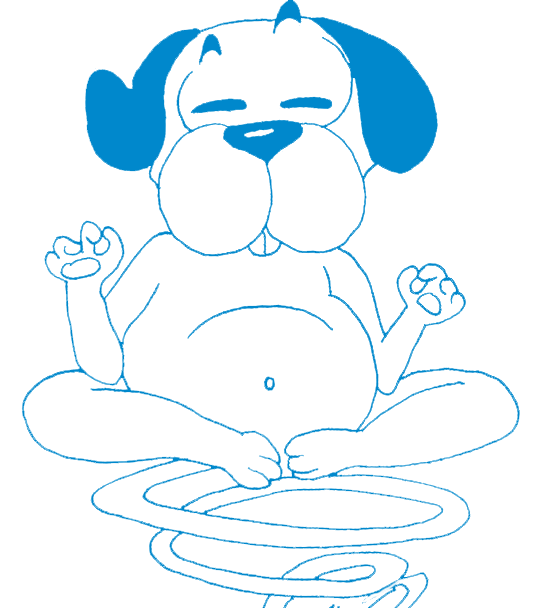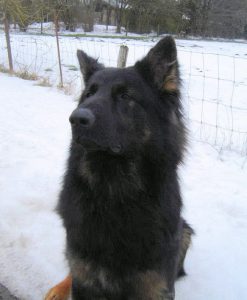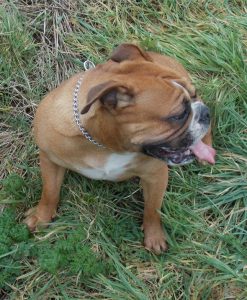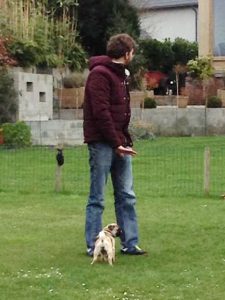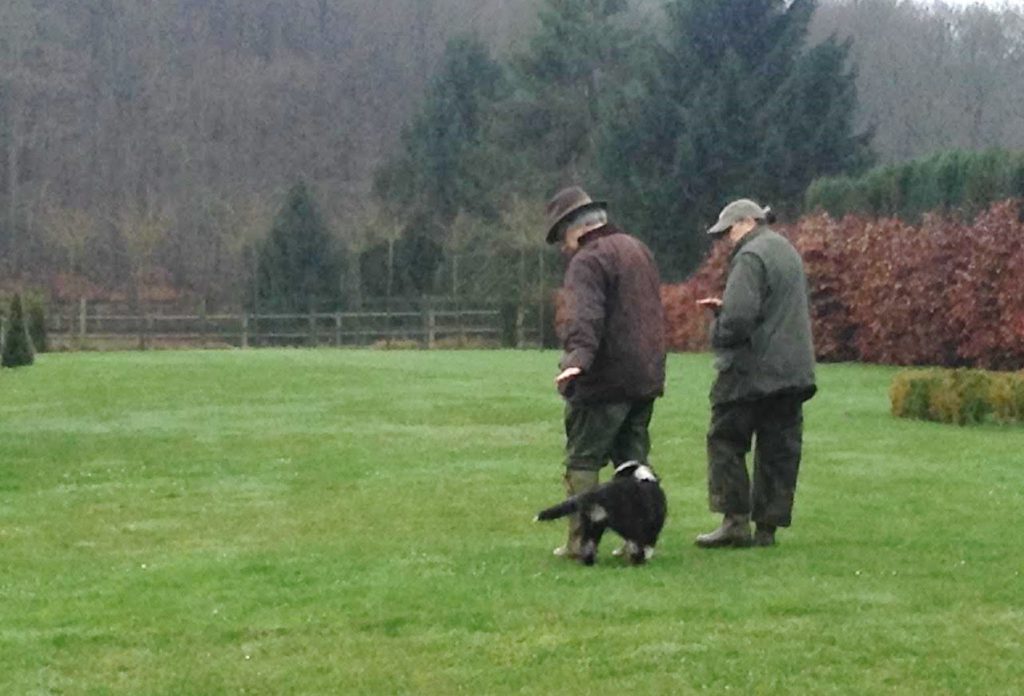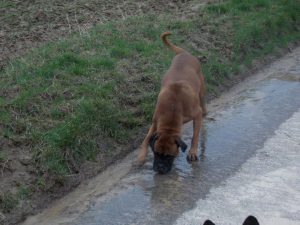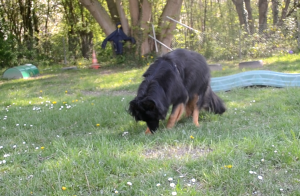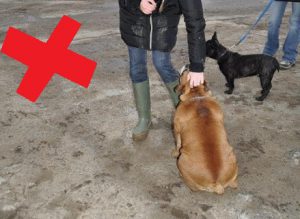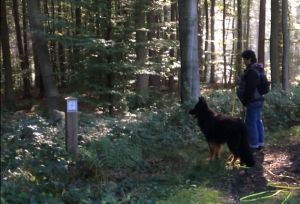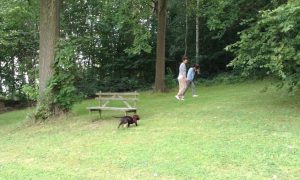While we mainly use verbal language to communicate, our dogs mainly use body language. Be aware of contradictions and misunderstandings:
- Let’s learn to observe our dog (postures, calming signals, displacement behaviours,…);
- Let’s make a hand signal each time it is necessary to help, reassure, support our dog;
- Never force our dogd;
- Let’s be polite with our dogd;
- Let’s learn to communicate our requests clearly (let’s think like a dog !).
Body language
Our dogs spend a lot of time observing their surroundings and especially observing US: nothing escapes them! The position/direction of the shoulders, hips, head or a wrinkled forehead, frowning eyebrows, a smile, squinted eyes, a tight or relaxed jaw, … We go to the wardrobe, put on our shoes or walking coat, take the harness and leash. At what point did our dog realise that he was going for a walk with us? Very quickly, and in any case long before the harness and leash are in our hands! They spend a lot of time observing us and memorising our daily routine. Our body language is made up of so many clues for them.
While humans mainly use their voice as a means of communication, our dogs prefer body language. If a person gives two contradictory messages with each means of communication simultaneously, our dogs will opt for what they understand best: body language.
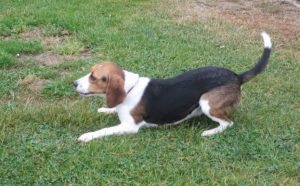
“Will you play with me?” A calming signal? |
|
My dog is in the garden, I am standing on the doorstep, facing the garden, and I invite him in. I call him (verbal communication meaning “come and go inside”) but I face my dog and partially obstruct the doorway (physical communication meaning “don’t enter”). I am broadcasting two contradictory pieces of information. It is very likely that my dog will respond to the information of my body language: “You don’t want me to come in? OK, I’ll stay in the garden”. So much frustration for the human, given that the dog has not responded to the verbal invitation, the preferred means of communication for humans. Let’s pay attention to the messages we convey to them through our body language.
Since our dogs communicate mainly with their body language, let’s learn to read it in order to avoid unfortunate misunderstandings. Once we have learned to observe and recognise our dog’s facial expressions and postures, we can see if something is bothering him, if something is ” blocking” him. Our dog is not “disobedient”, he is simply confused by the lack of precision in the requests we make of him.
Recommended books and DVD:
- On talking terms with dogs: calming signals by Turid Rugaas (book and DVD)
- Understanding the silent communication of dogs by Rosie Lowry.
Calming signals
Recommended book: On talking terms with dogs: calming signals by Turid Rugaas (book and DVD)
Ethologists call “calming signals” the postures, looks, facial expressions and movements that dogs produce to calm themselves, to diffuse a tense situation, to express their peaceful intentions or to communicate to the other individual that they are in an uncomfortable emotional state. [1] When our dogs lick their lips, freeze, scratch and yawn, it’s never without reason! If a dog yawns when he has just woken up, it is of course a basic biological function. And when he scratches, it may be to get rid of an itch in his fur. We should always ask ourselves whether our pet is giving off a calming signal and take it into account.
Our dogs can send out these calming signals in many situations that escape us: a plane or a hot-air balloon, people we pass on a walk, a car, a bark in the neighbourhood (or any other animal noise), fireworks or even the noises produced by the television set, an object that we have dropped on the ground,… If we can help our dog to be more comfortable in the situation, why not do it? There is a very simple means at our disposal: the hand signal.
[1] Source: Véronique Valy, canine consultant, Au’Tour du chien, France
|
|
|
The hand signal
This involves positioning our hand (palm facing our dog) between our dog and the object or source of the unpleasant noise. As our dogs communicate mainly with body language, they learn very easily everything that is visual. This signal is easy and possible to do under any circumstances.
Whenever something unsettling happens, this signal means “don’t worry, there is nothing to fear”. This gesture is simple to do and is very easy for our dog to understand (body language). He understands that we are there for him and to help him overcome the difficulties he faces. He can trust us.
This signal can be useful in many other circumstances: exciting situations (dog becomes overjoyed when you go for a walk or a beloved visitor arrives,…). Although the title of the book does not imply it, Turid Rugaas describes several problematic situations and adapted solutions using this hand signal in her book “Barking – The sound of a language“.
For dogs jumping on people, for example, a hand signal from the person being jumped up on, palm towards the dog, combined with clear body language: turn away from the dog (head, shoulders and hips) in another direction than the dog’s (turn your back on him for example), without looking at him, of course. As he learns, he will understand that this behaviour does not bring him any attention from us or from other people. In the end, the hand signal alone will be enough to dissuade our dog from jumping, meaning “I don’t want this kind of interaction with you”. Without getting angry, without pushing him, without shouting, a simple gesture of the hand is enough to communicate…
|
|
|
Displacement behaviours
In addition to the calming signals, our dog will also be able to produce displacement behaviours. This is a voluntary behaviour of the dog, appearing in a conflicting context (of hesitation). Our dog thinks to himself: “I am asked to do something but I don’t really want to (or I didn’t understand the request), I prefer to go and do something else elsewhere“. Our dog will then play, dig, smell a few blades of grass,… The displacement behaviour can also be a reaction to an uncomfortable environment: “All those cars passing by me so fast are scary, I prefer to pick up that empty can there and carry it around, it will make me think of something else”. In this case, taking distance from the cars and giving a hand signal will help our dog to overcome the difficulty.
As a second example: my dog is in the garden, and I am standing on the doorstep (blocking the doorway and facing him), inviting him to come in with my voice. He receives the two contradictory pieces of information (verbal and physical). Our dog can react to this contradictory information with a displacement behaviour: I tell him “come and enter” but my body tells him “don’t go through”, it is possible that he chooses a third solution. He will find something lying around in the garden (toy, stick,…) or will stop to pee or scratch the ground…
If our dog is doing a calming signal or a displacement behaviour, take that into consideration. Do not ever force your dog to do an activity or a game. Either he has a good reason (physical, emotional or other) to not participate, or he does not know how to respons because our request is not clear. It is better to ask ourselves if it is worth to insist. And if we think so, then ask ourselves how to send our message the most effective way (let us think about the dog ! ).
|
|
|
Politeness
This is what humans do, in their everyday life, without finding it rude or threatening:
- staring,
- walking straight towards another person.
Let us remember that, for our dogs, these two behaviours are threatening and confrontational. Turning our eyes away from our dog and approaching him in a curve or by going around him, is a matter of politeness and respect that we have for him.
Another extremely threatening gesture for our dogs is a hand on the neck or head. When we are standing next to our dog, the part of his body that is closest to our hand is his head. It is almost a reflex to put our hand on it: let’s be aware of the impact of our gesture. It is not a small thing for a dog to have a hand placed on his head or neck.
|
|
|
Verbal requests
Some use the word COMMAND. I prefer the word REQUEST.
Humans are talkative, let’s face it! Verbal communication is definitely our natural mode of communication, unlike our dogs. So let’s make an effort to make it easier for them to understand our requests.
Negative requests
“Do not jump”, “Do not eat”, “Do not let go”, “Do not roll in it”,… These requests are not clear. We count on the fact that our dog will make the difference between “to jump” and “not to jump”. This is unrealistic! We have enough vocabulary (and our dogs are capable of learning dozens of different requests) to say words to them that express what we want (instead of telling them what we don’t want).
We have all had this experience: “I’ll finish the dishes (or anything else) and we’ll go for a walk”. Our dog has understood “walk”, and is already having a party about his walk. He didn’t understand that we had a task to finish before devoting ourselves to him.
So let’s be clear:
- “Do not jump” can become “floor” or “ground”, which means: I ask you to put your 4 legs on the ground ;
- “Do not eat” can become “leave” or “ignore”, which means: I ask you to leave that nasty thing where it is;
- “Do not let go” can become “guard” or “hold”, for example to teach our dog to carry objects.
NO
This too must be a human reflex, but it is not at all clear. Not clear for our dogs? Of course, but not clear for humans either!
Let’s imagine that we approach an acquaintance, we talk to him during the approach and we put our hand on his shoulder. He or she says NO! Our movement is actually made up of a chain of movements/behaviours: the approach / the discussion / the hand put down / the look. What exactly does this person say NO to?
If he or she says “stop”, “be quiet” or “take your hand away” or “turn your eyes away”, we would have known exactly what we had to do. Just a NO is not clear. A bunch of NO’s is also unclear.
Out of curiosity, let’s do the test for a day: how many times today have I said no to my dog? On the first day of the test, the result will most certainly be more than ten. But we will be able to improve over time.
Intonations
However, we will have to pay particular attention to our intonations (a commanding voice or a joyful voice do not have the same effect on our dog) and tonalities (a high voice is exciting, while a low voice is soothing). If we ask our dog to stay put, for example, we will make sure that our request is calm, composed, with a low voice.
Body requests
Remember that all verbal requests can be replaced/completed by gestural or physical requests:
- To learn “follow me”: Let’s turn our body (from head to toes including shoulders and hips) in the direction we want to go, as soon as our dog moves towards us, we can reward/praise him;
- For a dog that jumps on people: Let’s look away and turn our whole body away (even turning our back completely if necessary). As soon as the paws are on the ground, we can reward/praise;
- For a dog that eats what he finds on a walk, including nasty things: Let’s turn our body towards the desired destination (certainly not towards the nasty thing), a hand signal towards the unwanted thing, and a call if necessary (a small sound signal that will help our dog to come back to us, like a whistle, a click of the tongue, or the word we taught him to follow us, like “follow me”). As soon as our dog comes towards us, let’s move away and reward/praise him.
To look at an object will help also our dog to understand which is the target.
|
|
|

